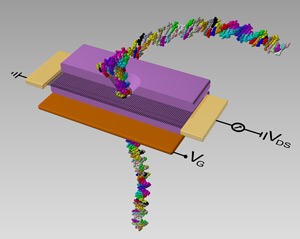By
Beckman Institute
Published on
Feb. 4, 2014
Matthew Gelber
Freeform 3D Printing
Biologists are increasingly using microfabrication to guide the behavior of cells in culture and to better approximate physiological structure and environment. In cancer particularly, where disease is diagnosed and graded based on abnormal tissue structure, recapitulating physiological structure in vitro is essential to developing representative disease models. Toward this end, I have developed freeform 3D printing, a method for creating 3D, branching channels in soft media. These channels and the surrounding medium can be seeded with cells to create an accurate model of the breast ducts, useful for in vitro studies of breast cancer. This technique can also be applied to make a variety of devices, from stents to monolithic microfluidic chips, and is scalable for applications ranging from millimeter-scale organs-on-chips to centimeter-scale vascularized tissues.
Michael Odarczenko
Environmentally Activated Self-Protecting Coatings
Coatings are commonly used in many industries, like automotive industries with car paints and oil industries with protective coatings on their pipelines. This project is working to develop a coating that cannot only protect the substrate while intact, but to have a continual functionality after the coating has been damaged. The forms of damage can include mechanical, corrosive, bacterial, and other environmentally harmful situations. Upon any type of damage, the coating will be designed to respond appropriately and counteract the damage form. This will be accomplished by imbedding liquid filled microcapsules into the coating. The liquid core will contain the protecting agent, and the capsule shell wall will be able to detect the environmental damage. For example when corrosion occurs, the local pH of the surrounding solution changes and the shell wall will be able to detect this change in chemical composition and release the anti-corrosive liquid core. These coatings can increase the longevity and decrease the cost of repair of coated systems.
Anuj Girdhar
Graphene Quantum Point Contact Transistor for DNA Sensing
Using solid-state devices containing graphene nanoribbons to sense and potentially sequence DNA is a promising alternative to traditional methods. This talk will demonstrate the viability of using such devices for biomolecular sensing by calculating the electronic transport properties of graphene nanoribbons with nanopores interacting with translocating DNA molecules. By adjusting the nanoribbon edge geometry and carrier concentration, we will show how the device can be tuned to maximize its sensitivity to conformational and positional changes of molecules inside the nanopore. In addition, we will present a design for a multilayer device containing a nanoribbon and additional gate electrodes to simultaneously sense and control the motion of a biomolecule translocating through the nanopore.


